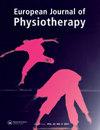The Borg scale is a sustainable method for prescribing and monitoring self-administered aerobic endurance exercise in patients with chronic kidney disease
IF 1.1
Q3 REHABILITATION
引用次数: 1
Abstract
Abstract Aim To examine adherence, performance, and safety of self-administered aerobic endurance exercise when exercise intensity was prescribed and self-monitored with the Borg RPE scale in patients with chronic kidney disease (CKD), and the relationship between performed exercise and change in walking distance. Materials and Methods 97 men and 50 women (age 66 ± 14 years, measured GFR 22 ± 8 mL/min/1.73m2) were prescribed 60 min aerobic endurance exercise/week at RPE 13–15. The 6-minute walk test was measured at 0, 4, 8 and 12 months of exercise. Results 100 patients completed the study, 80% reported exercise intensity at 12 months, 74% performed exercise within the prescribed RPE. Median RPE was 13 (13–15). Median duration was 56 (33–109) minutes/week. Patients with a short walking distance at baseline performed significantly less minutes of exercise/week (p = 0.039). There was no correlation between weekly duration and change in walking distance. No exercise-related incidents were recorded. Walking distance improved significantly by 30 ± 56 metres (p < 0.001). Conclusions The Borg RPE scale is useful, acceptable, simple and safe for prescribing and monitoring intensity of self-administered aerobic endurance exercise in patients with CKD. A RPE of 13–15 improved walking distance in well-functioning and deconditioned patients, within a wide range of weekly duration of exercise.博格量表是一种可持续的方法,用于处方和监测自我给予有氧耐力运动的慢性肾脏疾病患者
摘要目的研究慢性肾脏病(CKD)患者在规定运动强度并使用Borg RPE量表进行自我监测时,自主有氧耐力运动的依从性、性能和安全性,以及所进行的运动与步行距离变化之间的关系。材料和方法97名男性和50名女性(66岁 ± 14 年,测量GFR 22 ± 8. mL/min/1.73m2)60 RPE 13-15时每周进行的最小有氧耐力运动。在0、4、8和12时测量6分钟步行测试 几个月的运动。结果100名患者完成了研究,80%的患者在12岁时报告了运动强度 74%的患者在规定的RPE范围内进行了锻炼。RPE中位数为13(13-15)。中位持续时间为56(33-109)分钟/周。基线时步行距离较短的患者每周运动分钟数显著减少(p = 0.039)。每周持续时间与步行距离的变化之间没有相关性。没有与演习有关的事件记录。步行距离显著提高了30 ± 56米(p < 0.001)。结论Borg RPE量表可用于CKD患者自行管理有氧耐力运动的处方和监测强度,是有用的、可接受的、简单的和安全的。13–15的RPE改善了功能良好和有条件的患者在一周的大范围运动中的步行距离。
本文章由计算机程序翻译,如有差异,请以英文原文为准。
求助全文
约1分钟内获得全文
求助全文

 求助内容:
求助内容: 应助结果提醒方式:
应助结果提醒方式:


